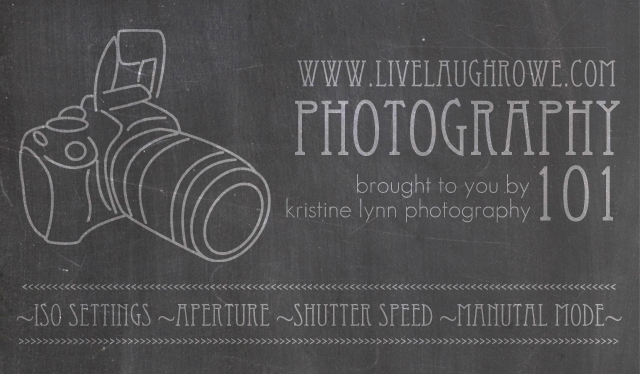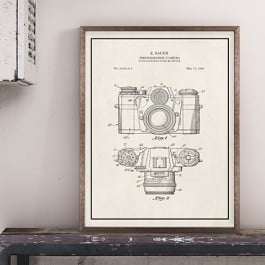Happy Spring! I’m excited to be joining you with another edition of the Photography 101 Series! Before I jump in…how did you do with ISO? Did you go and experiment with different ISO settings? In case you missed part one in the series, be sure to read up on the ISO Settings in part one of the series.
Well, today’s focus is on Aperture Settings. I think Aperture is great because it can give you a lot of creative ability as far as blurring or keeping your images in focus. So let me start with the definition of Aperture.
 Aperture Defined: A hole or an opening through which light travels. The aperture is the opening inside the lens of your camera that adjusts larger or smaller to control the amount of light that enters the lens.
Aperture Defined: A hole or an opening through which light travels. The aperture is the opening inside the lens of your camera that adjusts larger or smaller to control the amount of light that enters the lens.
Aperture is also known as “f stop” and to simplify the definition…it’s what allows you to have those blurry backgrounds.
Lower aperture:
Lower aperture only allows for a small part of your photo to be in focus and then slowly gets blurrier as you go out from your focal point. If I shoot “wide open” (on the lowest number your lens will go) then I will probably only have one eye in focus but will have a nice blurry background. It is possible to get both eyes in focus, but you need to be sure your on the same plane as your subject. You would need your camera to be parallel to your subject’s eyes. Basically, get down on their level.
Higher aperture:
Higher aperture allows for more of your picture will be in focus. For example, if you are shooting people and only want them to be in focus then you want to make sure that your aperture is at least at the same number as there are people in the photo. (If I were taking picture of two individuals, I would want to make sure my aperture was at least at f/2.0…I usually keep it at f/2.8. If there are 5 people then you would want to be at least at f/5.0 and so on.) When shooting landscape you would want your aperture number to be a lot higher so that majority of your picture is in focus.
Changing your aperture affects the amount of light in your shot. The lower the number, the more light is brought in. The higher the number, the less light. Therefore, if you do a lot of indoor shooting, you’ll want a lens with a lower aperture such as f/1.8. I’ve included a little chart below that allows you to see how the openings control your light.

Lower number aperture = more light and a blurrier background
Higher number aperture = less light and a sharper background
What I did to practice when I first got started in photography was I went and bought a kids set of bowling pins. I placed them in a line that angled as it went along. Then I starting capturing images by starting to focus on the first pin and blur the rest of pins…then focus on the second pin…etc. This was a really fun way of seeing firsthand how aperture worked. Think about giving it a shot. The type of lens you use is also a big factor as to what aperture you can set your camera on. I encourage a 50mm, f/1.8 prime lens. This is an EXCELLENT lens if you are serious about learning how to shoot on manual, it’s an inexpensive lens with a pretty low aperture. Just note…some cameras are not compatible with this lens. Nikon users would go with a 35mm 1.8. If you have questions, feel free to email me at info@kristinelynn.com. HAPPY APERTURING!




Kirsty says
Great series! 😀
Kelly Rowe says
Thanks so much, Kristy! xo
Shannah @ Just Us Four says
I am still working hard on my photography skills so all of these tutorials are such a great help! Thank you so much for them.
Kelly – It was so great meeting you at Snap! I am glad we got to connect {and get a picture} because I love coming here and reading all your posts. #boobsup
Kelly Rowe says
Yay! I’m so happy that you’re finding these tutorials helpful.
Shannah! It was great meeting you too 🙂 Thanks for the laugh on #boobsup. Hugs to you, friend.
Cari says
I love this series! I took a photography class in HS but forgot most of the basics; including how much I love taking pictures:) Thanks Kristine!!
Kelly Rowe says
I’m so thrilled that Kristine’s series has been helpful, Cari!! Hugs.
Leslie Stewart @ House on the Way says
Thanks for this great info! I am constantly trying to perfect my photography skills. Love this series!
Leslie
Kelly Rowe says
Thanks, Leslie! I’m so glad to hear it’s been helpful. Have a fabulous end to your week. xo
Kimberly says
Great explanation. Thanks for sharing.
Kelly Rowe says
YAY! Always glad to hear that the information is helpful. Trust all is well, Kimberly. HUGS!!
Jelli says
I’m loving this series, ladies! Although I still don’t own a DSLR, I am learning a lot about camera functions so that some day when I somehow get a hold of more adjustable camera than my point-and-shoot, I’ll know (mostly) how to use it. Thanks for this info, Kristine!
Kelly Rowe says
So glad to hear that you’re enjoying this series, Jelli! We look forward to hearing about how you’re able to put this tips to use when you get a DSLR. Hugs!!
Jacque says
This was a great post. Thank you so much. I really enjoy your blog.
Kelly Rowe says
Awww. I’m so glad to hear that you enjoyed the post and the blog, Jacque! Thanks so much for stopping by. HUGS!
Mike says
What great articles to sharpen up your photography skills.
Kelly Rowe says
Thanks, Mike 🙂
Lana @ Never Enough Thyme says
The bowling pins are a great idea! Why didn’t I think of that?
Kelly Rowe says
Hee-Hee! They are great for practice. Have a great day, Lana!
Bonnie and Trish @ Uncommon says
Great post Kelly! We are slowly working on our photo skills and these posts are a huge help!
Kelly Rowe says
Thanks, ladies! Always glad to hear that this info is helpful 🙂 Hugs!
Rachel (Lines Across) says
Kristine, thanks for the great info! (And thanks Kelly for sharing this!) This question is a little off topic, but what lens would you recommend for taking portraits and head shots? Would you recommend a higher or lower aperture?
Theresa @DearCreatives says
Can’t wait to give it a try. Just got a new camera & super excited to get learning. Thanks for sharing!
Missy Johnson says
I am just now reading all of these tutorials, but they are extremely helpful, so THANK YOU!!! I do have one quick question though… I have a Canon Rebel T2i and a Canon 50mm f/1.8. I have the HARDEST time trying to get it to focus correctly on a subject if it’s more than 2-3 feet away. I bought this lens because everyone raved about it being the “go to lens” for everyday shooting, but it blurs every time I try to shoot something at a short distance. Please offer any advice that you may have. Thank you so very much!
– Missy